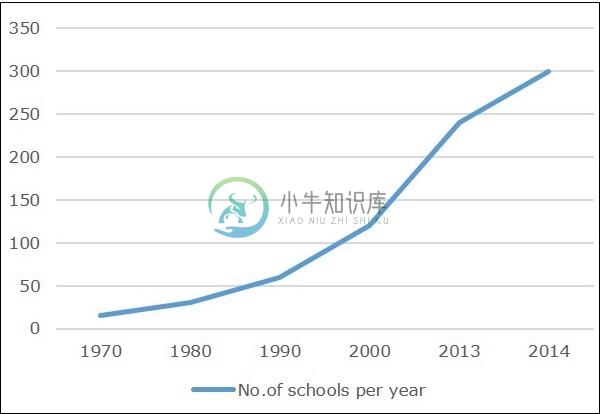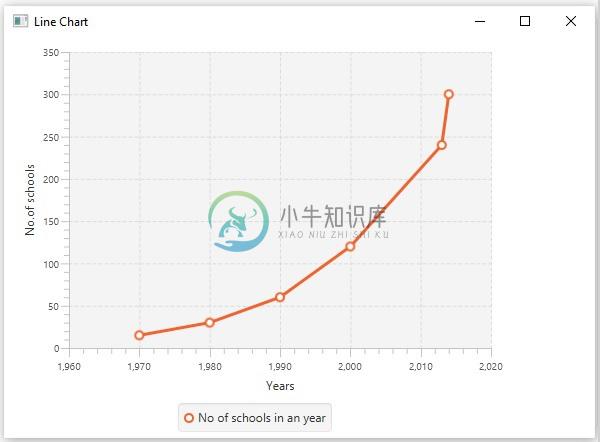Line Chart
折线图或折线图将信息显示为由直线段连接的一系列数据点(标记)。 折线图显示数据如何以相等的时间频率变化。
以下是描绘不同年份学校数量的折线图。

在JavaFX中,折线图由名为LineChart的类表示。 该类属于包javafx.scene.chart 。 通过实例化此类,您可以在JavaFX中创建LineChart节点。
生成折线图的步骤
要在JavaFX中生成折线图,您应该按照下面给出的步骤操作。
第1步:创建一个类
创建一个Java类并继承包javafx.application的Application类。 然后,您可以按如下方式实现此类的start()方法。
public class ClassName extends Application {
@Override
public void start(Stage primaryStage) throws Exception {
}
}
第2步:定义轴
定义折线图的X和Y轴并为其设置标签。
在我们的例子中,X轴代表从1960年到2020年的年份,每十年有一个主要的刻度线。
//Defining X axis
NumberAxis xAxis = new NumberAxis(1960, 2020, 10);
xAxis.setLabel("Years");
//Defining y axis
NumberAxis yAxis = new NumberAxis(0, 350, 50);
yAxis.setLabel("No.of schools");
第3步:创建折线图
通过实例化包javafx.scene.chart名为LineChart的类来创建折线图。 对于此类的构造函数,传递表示在上一步中创建的X轴和Y轴的对象。
LineChart linechart = new LineChart(xAxis, yAxis);
第4步:准备数据
实例化XYChart.Series类。 然后将数据(一系列,x和y坐标)添加到此类的Observable列表中,如下所示 -
XYChart.Series series = new XYChart.Series();
series.setName("No of schools in an year");
series.getData().add(new XYChart.Data(1970, 15));
series.getData().add(new XYChart.Data(1980, 30));
series.getData().add(new XYChart.Data(1990, 60));
series.getData().add(new XYChart.Data(2000, 120));
series.getData().add(new XYChart.Data(2013, 240));
series.getData().add(new XYChart.Data(2014, 300));
第5步:将数据添加到折线图
将上一步骤中准备的数据系列添加到折线图中,如下所示 -
//Setting the data to Line chart
linechart.getData().add(series);
第6步:创建组对象
在start()方法中,通过实例化名为Group的类来创建组对象。 这属于包javafx.scene 。
将在上一步中创建的LineChart(node)对象作为参数传递给Group类的构造函数。 这应该是为了将它添加到组中,如下所示 -
Group root = new Group(linechart);
第7步:创建场景对象
通过实例javafx.scene为Scene的类来创建一个Scene,该类属于包javafx.scene 。 在此类中,传递在上一步中创建的Group对象( root )。
除了根对象之外,您还可以传递两个表示屏幕高度和宽度的双参数以及Group类的对象,如下所示。
Scene scene = new Scene(group ,600, 300);
第8步:设置舞台的标题
您可以使用Stage类的setTitle()方法将标题设置为Stage 。 primaryStage是一个Stage对象,它作为参数传递给场景类的start方法。
使用primaryStage对象,将场景标题设置为Sample Application ,如下所示。
primaryStage.setTitle("Sample Application");
第9步:将场景添加到舞台
您可以使用名为Stage的类的方法setScene()将Scene对象添加到Stage 。 使用此方法添加前面步骤中准备的Scene对象,如下所示。
primaryStage.setScene(scene);
第10步:显示舞台的内容
使用Stage类的名为show()的方法show()场景的内容,如下所示。
primaryStage.show();
第11步:启动应用程序
通过从main方法调用Application类的静态方法launch()来启动JavaFX应用程序,如下所示。
public static void main(String args[]){
launch(args);
}
例子 (Example)
下表描述了1970年至2014年期间某地区的学校数量。
| 年 | 学校数量 |
|---|---|
| 1970 | 15 |
| 1980 | 30 |
| 1990 | 60 |
| 2000 | 120 |
| 2013 | 240 |
| 2014 | 300 |
以下是一个Java程序,它使用JavaFX生成描绘上述数据的折线图。
将此代码保存在名为LineChartExample.java的文件中。
import javafx.application.Application;
import javafx.scene.Group;
import javafx.scene.Scene;
import javafx.stage.Stage;
import javafx.scene.chart.LineChart;
import javafx.scene.chart.NumberAxis;
import javafx.scene.chart.XYChart;
public class LineChartExample extends Application {
@Override
public void start(Stage stage) {
//Defining the x axis
NumberAxis xAxis = new NumberAxis(1960, 2020, 10);
xAxis.setLabel("Years");
//Defining the y axis
NumberAxis yAxis = new NumberAxis (0, 350, 50);
yAxis.setLabel("No.of schools");
//Creating the line chart
LineChart linechart = new LineChart(xAxis, yAxis);
//Prepare XYChart.Series objects by setting data
XYChart.Series series = new XYChart.Series();
series.setName("No of schools in an year");
series.getData().add(new XYChart.Data(1970, 15));
series.getData().add(new XYChart.Data(1980, 30));
series.getData().add(new XYChart.Data(1990, 60));
series.getData().add(new XYChart.Data(2000, 120));
series.getData().add(new XYChart.Data(2013, 240));
series.getData().add(new XYChart.Data(2014, 300));
//Setting the data to Line chart
linechart.getData().add(series);
//Creating a Group object
Group root = new Group(linechart);
//Creating a scene object
Scene scene = new Scene(root, 600, 400);
//Setting title to the Stage
stage.setTitle("Line Chart");
//Adding scene to the stage
stage.setScene(scene);
//Displaying the contents of the stage
stage.show();
}
public static void main(String args[]){
launch(args);
}
}
使用以下命令从命令提示符编译并执行保存的java文件。
javac LineChartExample.java
java LineChartExample
执行时,上述程序生成一个显示折线图的JavaFX窗口,如下所示。


